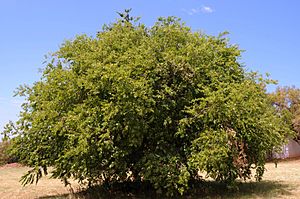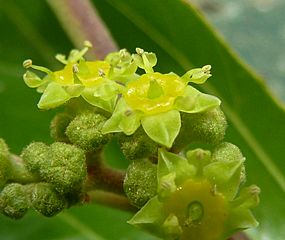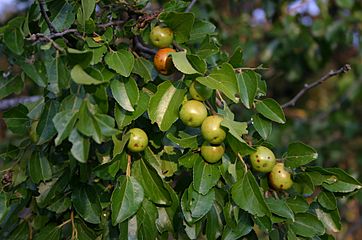Buffalo thorn facts for kids
Quick facts for kids Buffalo thorn |
|
|---|---|
 |
|
 |
|
| habit (summer) and fruit (winter) | |
| Scientific classification | |
| Genus: |
Ziziphus
|
| Species: |
mucronata
|
| Synonyms | |
|
|
The buffalo thorn (scientific name: Ziziphus mucronata) is a type of tree that belongs to the Rhamnaceae family. It grows naturally in southern Africa. This tree loses its leaves every year and can grow up to 17 meters (about 56 feet) tall. It can live in many different kinds of soil and habitats. You often find it in open woodlands, especially near rivers or on termite mounds.
The Zulu people call it “umLahlankosi.” This name means it was used to mark the graves of important tribal chiefs. The Afrikaans name “Blinkblaar-wag-'n-bietjie” describes its shiny, light green leaves and its tricky hooked thorns. The name means "shiny leaf wait-a-bit" because the thorns can snag you!
Contents
What Does the Buffalo Thorn Look Like?
The buffalo thorn is usually a small to medium-sized tree. It often reaches about 10 meters (33 feet) tall, but can sometimes grow to 17 meters (56 feet).
Its bark changes as the tree gets older. On young branches, it's reddish-brown. On older trees, it becomes rough and turns a dark gray or brown. The bark often cracks into small rectangular shapes.
The branches of the buffalo thorn are quite special. They grow in a zigzag pattern. Each little branch has two thorns that grow in a pair. One thorn is straight, and the other is hooked like a fishing hook. This makes them very good at catching onto things! Sometimes, very old trees lose their thorns completely.
The tree has greenish-yellow flowers that appear in thick bunches from October to April. These flowers have a silvery shine. The fruit of the buffalo thorn grows from February to August. They are smooth and hard, and when they are ripe, they turn a deep reddish-brown color. Some of these fruits can be bigger than grapes.
Where Does the Buffalo Thorn Live?
The buffalo thorn's small, greenish-yellow flowers are very popular with insects. They make a lot of sweet liquid called nectar, which is why bees use them to make honey.
Many different kinds of birds enjoy eating the brownish-red fruits of the buffalo thorn. Wild animals and farm animals also like to eat the leaves and fruits. For example, giraffes and impala often munch on the leaves.
How Do People Use the Buffalo Thorn?
The buffalo thorn tree is very useful. Because its young branches have so many thorns, it makes a great natural fence. The thorns are hard to get untangled because one points forward and the other points backward.
Some tribes believe that standing under a buffalo thorn tree during a thunderstorm will protect you from lightning. It is also sometimes planted to mark the graves of important chiefs.
Traditional Uses
People have used different parts of the buffalo thorn for many years.
- For health: A mix made from the roots can be used to help with pain and stomach problems. The bark and leaves are used for breathing issues and skin infections. A paste made from the roots and leaves can help treat boils, sores, and swelling. Crushed leaves can also be used to stop bleeding. Some people use steam baths made from the bark to help their skin. In East Africa, roots are used to treat snake bites.
- For food: The leaves of the buffalo thorn are safe to eat and can be cooked like spinach. The seeds can be roasted and ground up to make a drink similar to coffee. The fruits are not very tasty on their own, but a type of beer can be made from them. The Ovambo people use the fruit to make a traditional drink called ombike. The leaves and fruits are also an important food source for farm animals.
- Other uses: Branches from the tree are sometimes used to protect cattle pens (called kraals) and even graves. The wood is also used to make tools and as fuel for fires.
Cultural Beliefs and Stories
The buffalo thorn tree holds a special place in the culture and beliefs of many people, especially the Zulus.
The Zulus used to plant a buffalo thorn tree on the grave of a chief. This was a way to remember where the chief was buried. This is why their name for the tree, “umLahlankosi,” means “that which buries chief.”
There is also a belief that a branch from the buffalo thorn can help bring the spirit of a person who has passed away back home. A family member might go to the place where the person died, carrying a buffalo thorn branch. They believe the spirit can hold onto this branch. Then, the spirit is brought back to the family's home to find a new resting place. During this journey, the person carrying the branch will not look backward. They might even pay for two seats on a bus or taxi, talking to the spirit and explaining what is happening, like "we are now crossing the river."
Another Zulu belief is that if you are standing under a buffalo thorn during a lightning storm, you will be safe. They believe the tree cannot be struck by lightning. They also believe that if a buffalo thorn tree is cut down in the summer, it could cause a drought or a hail storm.
When a farmer died and was buried in their cattle or goat pen, branches of the buffalo thorn were sometimes placed on the grave. This was so the animals would nibble on the leaves and twigs, and in this way, they would understand that their owner had passed away. In other areas, people drag a buffalo thorn branch around their village. They believe it protects the village from bad spirits.
Gallery






